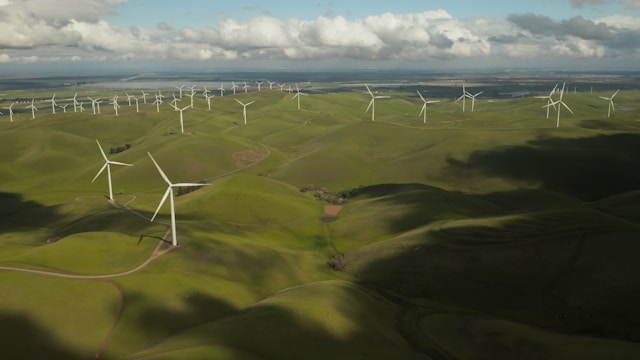Green technology, also known as sustainable technology, is a rapidly growing field that focuses on creating and implementing innovative solutions to minimize the negative impact of human activities on the environment. It encompasses a wide range of practices, products, and technologies that aim to conserve natural resources, reduce pollution, and promote sustainable development.
In recent years, there has been a growing awareness of the need to adopt green technology to address the pressing environmental challenges we face today, such as climate change, deforestation, and pollution. Governments, businesses, and individuals are increasingly recognizing the importance of transitioning to a more sustainable and eco-friendly way of living and operating.

This article aims to provide a comprehensive understanding of green technology, its applications, its potential impact on the environment and society and many more. By the end of this article, readers will have a clear understanding of the significance of green technology and its role in building a sustainable future.
Green technology refers to the development and application of products, services, and processes that use renewable materials and energy sources, reduce emissions and waste, and have a minimal impact on the environment. The main objective of this technology is to create sustainable solutions that address environmental challenges and promote a more sustainable way of living. It encompasses various fields such as energy, transportation, waste management, water conservation, and agriculture aims to minimize the negative impact of human activities on the environment. It focuses on finding innovative and eco-friendly alternatives to traditional technologies and practices.
In essence, green technology is about finding ways to meet our present needs without compromising the ability of future generations to meet their own needs. It is a holistic approach that considers the environmental, social, and economic aspects of sustainability.
The concept of green technology emerged in response to the growing concerns about climate change, pollution, and the depletion of natural resources. It aims to provide sustainable solutions to these environmental challenges by promoting the use of clean and renewable energy, improving energy efficiency, and reducing carbon emissions.
Green technology encompasses a wide range of fields, including renewable energy, energy efficiency, waste management, water conservation, and sustainable agriculture. It involves the development and implementation of innovative technologies, practices, and policies that promote environmental sustainability.
Over the years, green technology has gained significant attention and support from governments, businesses, and individuals worldwide. It has become a key focus area for research and development, as well as a driver of economic growth and job creation.
The adoption of green technology is driven by various factors, including the need to mitigate climate change, reduce dependence on fossil fuels, improve air and water quality, and enhance resource efficiency. It offers numerous benefits, such as cost savings, improved public health, and a more sustainable future.
However, the widespread adoption of green technology faces challenges, including high initial costs, limited infrastructure, and resistance to change. Despite these challenges, the importance of green technology in addressing environmental issues and promoting sustainable development cannot be overstated.
Malaysia has been actively promoting and implementing green technology initiatives in recent years. The government has recognized the importance of sustainable development and has taken steps to encourage the adoption of green technology in various sectors.
One of the key initiatives in Malaysia is the Green Technology Master Plan (GTMP) 2017-2023. The GTMP aims to drive the development and adoption of green technology in the country by providing a roadmap and framework for implementation. It focuses on six key sectors: energy, buildings, waste management, transportation, water, and agriculture.
In the energy sector, Malaysia has been investing in renewable energy sources such as solar, wind, and biomass. The government has set a target to increase the share of renewable energy in the country’s energy mix to 20% by 2025. This has led to the development of solar farms, wind farms, and biomass power plants across the country.
In the building sector, Malaysia has implemented the Green Building Index (GBI) certification system, which promotes the design and construction of energy-efficient and environmentally sustainable buildings. The GBI certification is awarded to buildings that meet certain criteria, such as energy efficiency, water efficiency, indoor environmental quality, and sustainable site planning.
In the waste management sector, Malaysia has been focusing on waste-to-energy projects to reduce the reliance on landfilling. The government has encouraged the development of waste-to-energy plants that convert waste into electricity or heat. This not only helps to reduce the amount of waste going to landfills but also generates renewable energy.
In the transportation sector, Malaysia has been promoting the use of electric vehicles (EVs) and hybrid vehicles. The government has introduced various incentives, such as tax exemptions and subsidies, to encourage the adoption of EVs and hybrid vehicles. Charging infrastructure for EVs has also been installed in major cities.
In the water sector, Malaysia has implemented various initiatives to promote water conservation and efficient water management. This includes the use of rainwater harvesting systems, water-efficient irrigation techniques, and the implementation of water recycling and reuse systems.
In the agriculture sector, Malaysia has been promoting sustainable farming practices and the use of organic fertilizers and pesticides. The government has provided support and incentives to farmers who adopt sustainable farming methods, such as organic farming and agroforestry.
Green technology has a wide range of applications across various industries. One of the key areas where green technology is being applied is in the energy sector. Renewable energy sources such as solar power, wind power, and hydropower are being harnessed to generate electricity in a sustainable and environmentally friendly manner. These sources of energy not only reduce greenhouse gas emissions but also help in reducing dependence on fossil fuels.

Another important application of green technology is in the transportation sector. Electric vehicles (EVs) are becoming increasingly popular as a greener alternative to traditional gasoline-powered cars. EVs produce zero tailpipe emissions, reducing air pollution and improving air quality. Additionally, green technology is also being used to develop more efficient and eco-friendly public transportation systems, such as electric buses and trains.


Green technology is making a significant impact in the construction industry through the use of sustainable building materials and practices to create energy-efficient and environmentally friendly buildings. This includes the use of recycled materials, energy-efficient insulation, and smart building systems that optimize energy consumption. Green buildings not only reduce the carbon footprint but also provide a healthier and more comfortable living and working environment.
Green Technology City, also known as Eco-City, embodies these principles on a larger scale by integrating renewable energy sources such as solar panels, wind turbines, and geothermal systems to reduce reliance on fossil fuels and mitigate climate change. These cities also promote sustainable transportation and innovative waste management systems, striving to foster a more sustainable and environmentally friendly urban lifestyle.
The agriculture sector is also benefiting from the application of green technology. Sustainable farming practices, such as organic farming and precision agriculture, are being adopted to minimize the use of chemical fertilizers and pesticides, reduce water consumption, and improve crop yields. Green technology is also being used to develop innovative solutions for waste management and recycling in the agricultural sector.
Furthermore, green technology is being utilized in the manufacturing industry to develop more sustainable and eco-friendly processes. This includes the use of cleaner production techniques, recycling and waste reduction strategies, and the development of green materials. By implementing green technology in manufacturing, companies can reduce their environmental impact and improve resource efficiency.
Lastly, green technology is being applied in the waste management sector to promote recycling and waste reduction. Advanced waste treatment technologies, such as anaerobic digestion and composting, are being used to convert organic waste into renewable energy and nutrient-rich compost. Recycling technologies are also being developed to recover valuable materials from waste streams, reducing the need for raw material extraction and minimizing landfill waste.
Green technology offers numerous advantages that make it an attractive option for sustainable development. One of the key advantages is its positive impact on the environment. By using renewable energy sources and reducing carbon emissions, green technology helps to mitigate climate change and preserve natural resources. Additionally, green technology promotes energy efficiency, which leads to cost savings for individuals and businesses. It also creates new job opportunities in the renewable energy sector.
However, green technology also has its limitations and disadvantages. One of the main challenges is the high initial cost of implementing green technology solutions. The installation of solar panels, wind turbines, and other renewable energy systems can be expensive, making it difficult for some individuals and businesses to afford.
Another disadvantage is the intermittent nature of renewable energy sources. Solar and wind energy, for example, are dependent on weather conditions and may not be available at all times. This can lead to fluctuations in energy supply and require backup systems or energy storage solutions.
Furthermore, the development and implementation of green technology require significant research and development efforts. This can be time-consuming and costly, especially for emerging technologies. Additionally, the integration of green technology into existing infrastructure and systems may pose technical challenges and require upgrades or modifications. Finally, there may be resistance to change and a lack of awareness or understanding of green technology among the general public, which can hinder its widespread adoption.
Green technology is a revolutionary approach to addressing environmental challenges and promoting sustainable development. It encompasses a wide range of practices, innovations, and technologies that aim to minimize the negative impact on the environment while maximizing resource efficiency.
In Malaysia, green technology has gained significant attention and support from the government and various stakeholders. The country has implemented policies and initiatives to promote the development and adoption of green technology, aiming to become a regional leader in sustainable practices. As we move towards a more sustainable future, it is crucial to continue investing in research, development, and implementation of green technology. By embracing green technology, we can mitigate the adverse effects of climate change, protect our natural resources, and create a better world for future generations.
In summary, green technology is not just a buzzword; it is a necessity. It is our responsibility to embrace and promote sustainable practices in all aspects of our lives. Together, we can make a significant difference in preserving our planet for future generations.